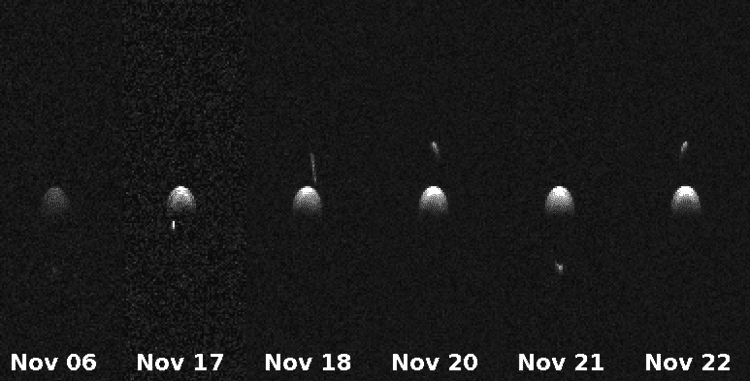Discovered by R. H. McNaught MPC designation (175706) 1996 FG3 Orbital period 394 days Aphelion 1.42 m | Discovery date 24 March 1996 Alternative names 1996 FG3 Observation arc 17.96 yr (6,560 days) Discovered 24 March 1996 Discoverer Robert H. McNaught | |
 | ||
Similar Solar System, (66391) 1999 KW4, (164121) 2003 YT1, 65803 Didymos, (341843) 2008 EV5 | ||
(175706) 1996 FG3 is a rare-type carbonaceous binary asteroid, classified as near-Earth object and potentially hazardous asteroid of the Apollo group, approximately 1.7 kilometers in diameter. It was discovered on 24 March 1996, by Australian astronomer Robert McNaught at Siding Spring Observatory in New South Wales, Australia. The asteroid was also a target of a rejected mission-proposal for the Marco Polo spacecraft.
The carbonaceous body is also classified as a rare B-type and hydrated C-type (Ch) asteroid, respectively. It orbits the Sun at a distance of 0.7–1.4 AU once every 13 months (395 days). Its orbit has an eccentricity of 0.35 and an inclination of 2° with respect to the ecliptic. It has an Earth minimum orbital intersection distance of 0.0283 AU (4,230,000 km), which corresponds to 11.0 lunar distances. As no precoveries were taken, and no prior identifications were made, the body's observation arc begins with its official discovery observation.
Several rotational light-curves of this asteroid were obtained from photometric observations taken by astronomers Petr Pravec, Petr Scheirich and Stefano Mottola, as well as by the Very Large Telescope's VISR instrument. The light-curves gave a well-defined rotation period of 3.594–3.595 hours with a brightness variation of 0.08 to 0.10 magnitude (U=3/3/3/3). The asteroid is an oblate ellipsoid with a nearly spherical shape.
During the photometric observations in December 1998, the binary nature of this asteroid was revealed. It was the first binary near-Earth asteroid for which eclipse events were detected in the visible spectrum. The binary system has a diameter ratio of 6999280000000000000♠0.28, a density of 1.4 g/cm3, and an ecliptic latitude of -84° for its mutual spin axis. The asteroid moon has a diameter of approximately 480 meters and an orbital period of 16.1508 hours. Its orbit is nearly circular, with an eccentricity of 0.1 and a semi-major axis of approximately 3.4 primary radii. The moon's rotation period remains unknown.
According to numerous observations, including the EXPLORENEOs survey, NASA's Wide-field Infrared Survey Explorer with its subsequent NEOWISE mission and the Spitzer Space Telescope, the asteroid measures between 1.55 and 1.90 kilometers in diameter and its surface has a low albedo of 0.03 to 0.05. The Collaborative Asteroid Lightcurve Link adopts an albedo of 0.04 and a diameter of 1.90 kilometers.
Due to its binary nature and its low delta-v heliocentric orbit (also see Hohmann transfer orbit), this asteroid was selected for MarcoPolo-R, which was the Marco Polo spacecraft's first proposed mission. MarcoPolo-R was originally selected for the assessment study phase in the M3 slot of ESA's Cosmic Vision program, but rejected in favor of PLATO by the end of 2012.
